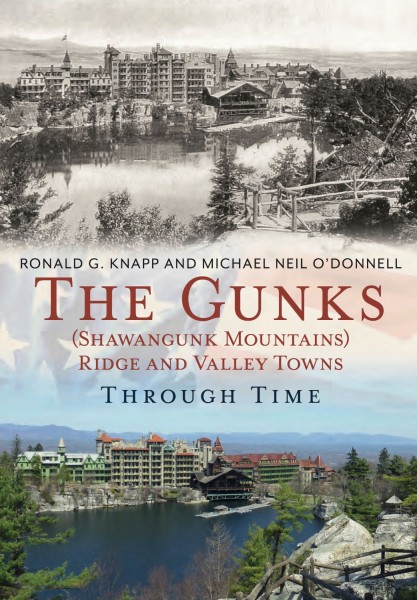
Whenever I explore The Gunks (Shawangunk Mountains), whether I’m hiking on the Mohonk Preserve or biking to Wallkill, I’m always amazed by the abundance of natural beauty. Somehow after centuries of human settlement, this area of New York is pretty undeveloped and hasn’t changed much, or so I thought.
The Gunks (Shawangunk Mountains) Ridge and Valley Towns Through Time by Ronald G. Knapp and Michael Neil O’Donnell provides a rich written and visual history of The Gunks and its surrounding towns.
O’Donnell, a landscape photographer, handled the 192 photos in the book which show how The Gunks have changed from before and through the 20th century.
Knapp, a cultural-historical geographer and SUNY Distinguished Professor Emeritus at SUNY New Paltz where he taught from 1968-2001, wrote the context for these photos and a detailed history of Ulster County.
After reading through the book and seeing old vs. new comparisons of areas in The Gunks and surrounding towns, I found that I was right. After a century, it seems like not much has changed after all. That’s a good thing.
The Mohonk Mountain House (that place you can’t afford to stay at but are welcome to cool down at after hours of hiking) was completed in 1910. One-hundred and five years later, it looks incredibly similar. Outside of a few paved roads instead of dirt roads meant for horse-carriages, it’s hard to tell what has changed.
Areas of natural beauty are as gorgeous today as they were a century ago. Water still plummets down the Awosting Falls in Rochester and Eagle Cliff is even more densely populated with trees.
You can thank the Mohonk Preserve and Minnewaska State Park Preserve for this. They’ve done an amazing job of conserving The Gunks. When you consider the many failings to protect natural landscapes across the U.S. in the last century, The Gunks’ near-pristine state is practically miraculous.
And it doesn’t seem like conservation efforts will cease anytime soon. The Mohonk Preserve is New York State’s largest non-profit nature preserve with an estimated 165,000 visitors every year. The Minnewaska State Park Preserve has actually expanded in size over the last decade.
Not only does this book document natural landscapes, but also the history of the town of New Paltz.
I’m sure you didn’t know that New Paltz was founded in 1677 when 12 French Huguenot settlers bought rights to the land from a Lenape tribe known as the Esopus for “40 kettles, 40 axes and lots of wampum.” I don’t know exactly how much wampum was exchanged but I’m gonna call that a deal for the Huguenots.
I bet you didn’t know that P&G’s (yes, the same bar you get trashed at every Thursday) was constructed in 1900 as an open summertime venue for music, dance and relaxing. The building didn’t become a bar until 1947, when it was purchased by Pat Cafferty and George Jayne, who named it Pat and George’s.
Or that Old Main, built in 1909, is the oldest building on campus … alright you probably could’ve guessed that.
While this book is comprehensive, it doesn’t feel daunting or overwhelming. At 96 pages long it feels just right, like a 10-person fantasy football league or October New Paltz weather.
Strange analogies aside, I can’t do the photos in this book justice. It’s just incredible to see direct comparisons of Main Street or Lake Minnewaska with their 19th century counterparts.
Knapp did a great job of keeping the writing interesting. I never thought I’d be so interested in reading about the history of places I’ve never even been to, like the town of Gardiner.
The Gunks (Shawangunk Mountains) Ridge and Valley Towns Through Time directly benefits its subject material as all proceeds from the book go to the Mohonk Preserve. I recommend it for anyone who is remotely interested in The Gunks or the history of Ulster County. Or if you just really like pretty pictures.
New Paltz students can find the book at Rock & Snow, Dedricks Pharmacy & Gifts, Shapers, Inquiring Minds Bookstore, Barner Books, Handmade & More and The Treehouse. For more information about the book and a sample of some of its incredible photographs, visit gunksthroughtime.com.
